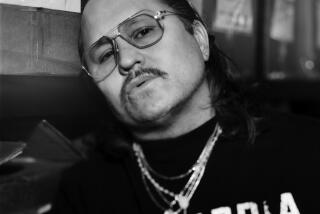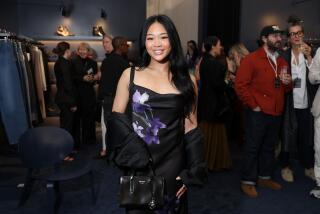Designer Michael Kors sticks to reality
Having dinner with Michael Kors is like having dinner with Auntie Mame. When you sit down with him, you know nobody is going to be at a loss for words or laughs.
Over hamburgers and vodkas a few nights before his spring runway show last September, he was full of quotable quotes.
On his spring collection: “It’s all about the anti-stiletto and the anti-tight dress. I can’t stand to see one more warrior” woman.
His favorite getaway: “We’ve gone to Big Sur three times in the last year and a half. For as much of a city boy as I am, nothing beats nature and luxury combined. We get no reception!”
And his dream designer collaboration: “I want a deal with In-N-Out Burger — to do a special sauce or a wrapper. I’m horseradish-obsessed!”
It’s shaping up to be quite a year for Kors, who is celebrating the 30th anniversary of his business. While the recession has caused many designers to scale back, Kors is in expansion mode. By the end of 2011, he expects to have 200 of his own boutiques worldwide, including his first in Paris, on Rue du Faubourg Saint-Honore, in addition to the 1,000 department and specialty stores that already sell his clothing and accessories. And his company is on track to hit $1 billion in sales.
Then there’s “Project Runway,” which will start shooting its ninth season soon. The reality TV show has exposed Kors to a different kind of audience, and made him a household name thanks to his clever critiques of contestant designs. Among his more memorable zingers after seeing models come down the runway? “She looks like a paper brioche.” “She looks like barefoot Appalachian L’il Abner Barbie.” “She looks like a pole dancer in Dubai.”
“I don’t know where that comes from,” says Kors, 51, who lives in New York with his boyfriend, Lance LePere. “I just go with my visceral reaction.”
Humorous quips aside, Kors is the show’s pragmatist, concerned always with what real women will really wear. (The battle lines were drawn in the finale of Season 8 when he snubbed fan favorite Mondo Guerra in favor of Gretchen Jones and her more commercial look, leading to uproar on the Web.)
Kors’ clothes have a similar no-nonsense appeal: the thickest of cashmere sweaters, great-fitting tropical wool trousers, double-face wool shift dresses that skim but don’t cling. Even when his imagination takes him from the Upper East Side to Capri to Santa Fe, his designs never veer far off course.
It’s the designer’s ability to stay rooted in reality that has made him so successful, according to Ken Downing, the fashion director of Neiman Marcus, who calls Kors “the ultimate fashion maestro.”
“If you learn anything in life,” Kors says, “it’s what works. And I’ve been around long enough that I don’t feel totally obnoxious using myself as an adjective.”
So what is Michael Kors? “I like hot weather clothes mixed with cold weather clothes. A big camel turtleneck over shorts, beaded pants worn with a casual top and gold jewelry with a bathing suit,” he says. “It’s the balance of someone who is feminine but sporty, sexy but laid back — the diva next door.”
The contradictions at the heart of his design philosophy come from what he calls his “bicoastal brain.” Kors grew up in Long Island, New York, but visited his grandparents on the West Coast often. “I was smit-ten,” he says. “L.A. in the 1970s was heaven on earth, Giorgio Beverly Hills, ‘Scruples’…” (the latter a reference to Judith Krantz’s 1978 potboiler, which revolves around a Rodeo Drive boutique). His mother Joan Kors has lived in Los Angeles for 30 years and is the brand’s West Coast ambassador.
He might have gone into show business had he not been “the rare species of gay man who can’t sing and dance.”
Instead, he built a fashion business in the image of the moneyed set, from the Park Avenue princesses of the East Coast to the paparazzi princesses of the West Coast. Over dinner, he tells anecdotes about the Olsen twins, Nicole Richie, Blaine Trump and cosmetic executive Aerin Lauder. He’s dressed them all, and everyone who’s anyone, really, including the most wanted fashion celebrity in the universe, First Lady Michelle Obama — and not just once, but more than 30 times.
What he won’t do is pander to the awards show set, so don’t count on seeing Michael Kors on the red carpet at this year’s Golden Globes. “If it’s a client of ours, or someone I’m intrigued by, then collaboration is great. But we’re never going to have rolling racks with ball gowns all over town. That’s not who we are.”
These days, he’s just as happy to dress the women of Omaha and Indianapolis, and make them feel like celebrities in their own lives. Between the $18,000 lynx fur vest in his high-end runway collection, and the $130 faux-fur vest in his more affordable Michael Michael Kors line, he’s got both jet set and coach class covered.
“Initially, my clothes couldn’t be expensive enough,” he says. That attitude began to change in the early 1990s when he licensed a collection called Kors, which was priced too high for what was supposed to be an affordable luxury line and ultimately was discontinued.
When he launched Michael Michael Kors in 2004, the collection was under his control, instead of a licensee’s, with prices in the sweet spot between $79 and $800. It was the same year he debuted as a judge on “Project Runway.” The timing couldn’t have been better. Fashion became more accessible, and Kors became a financial success.
“I went from thinking fashion was only the provenance of big-city affluent people, to thinking you could be 14 or 80, live in the city or suburbs, have endless money or a limited budget, and buy something great-looking at the right price for you. The world has changed, and people look and feel better for it.”
Within a 5-mile radius of Kors’ Rodeo Drive collection store, there are four Michael Michael Kors stores — at the Beverly Center, Grove, Westfield Century City and Santa Monica Place malls. There, the merchandise has the same whiff of class, even if the luggage brown sandals are $185 instead of $750. (Interestingly, Kors sells both lines alongside each other at https://www.michaelkors.com.)
When it comes to the lower-priced collection, “I always say, ‘If you blurred your eyes, would the wealthiest person in the world want to wear it?’ If the answer is no, we don’t make it.”
Now that he’s mastered the high-low retail mix, the next fashion frontier is sustainability, he says. His back-to-nature-themed spring collection features a smocked “shrub print” shredded taffeta skirt and a daffodil yellow popover dress. But he didn’t just reference nature in color and print: He also took a step toward preserving it, by incorporating hemp and other sustainable fabrics. His design team continues to work with fabric mills on sourcing organic lace and cashmere.
He also has further ambitions in the entertainment industry, and is represented by Creative Artists Agency. But don’t expect a film like Tom Ford’s “A Single Man.”
“My real love is theater and stage. But unfortunately, my day job is busy, to say the least,” he says. “Could we see Michael Kors the impresario in the future? Maybe. Producing something would be intriguing.”
But mostly, he’s excited to keep designing.
“There will be another 30 years. I’m not 80,” he says. “This isn’t the hydraulic lift coming up at the Oscars and the slow wave. I still feel like a kid.”







